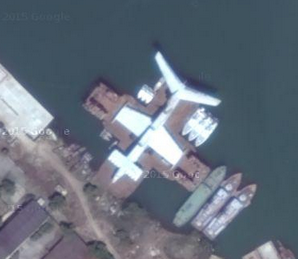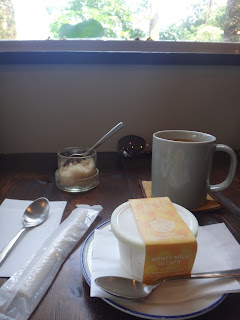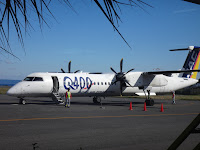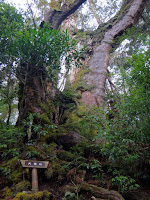 |
| Also known as the High-speed ferry (高速船), Toppy (a local word meaning "flying-fish"), Cosmoline, and Rocket, you can buy your tickets on the Japanese website. |
Let's not get this confused with a hovercraft. While both hydrofoils and hovercraft work on the concept that a boat can go faster if it can get it's haul out of the water, that's pretty much where the similarities end.
Boeing touts their passenger hydrofoil craft as "smooth," "fast," and "as quiet as a conventional auto ferry." Because it rides mostly above the water, it creates much less wake than conventional boats, and the way it "platforms" across the water gives a very stable ride without all the sea-sick rocking. I think it feels like riding in an airplane that never takes off.
When Boeing launched the $6 million (now a used one costs more like $8mil) 250-seat, 45-knot/50mph 929 craft in 1974, they called it the JETFOIL, the marriage of jet-engine propulsion and lift from wing-shaped foils. It's just like a jet airplane except that it works with jets of water and the foils are underwater.
 |
| This copy of a drawing printed in the April 1973 issue of Popular Science, after Boeing announced the JETFOIL project, shows the position of the hydrofoils. Although they live up to specs, they never became as popular in the states as the article's author envisioned* |
When "hullborne," it can turn on a dime and even pull into port almost sideways! Once the 929 leaves the dock and starts to pick up speed, aft and forward "wings" are lowered below the craft. Then it "takes off" and becomes "foilborne." (I'm not sure that's a real word, but you'll see it if you ride the JETFOIL.) It uses an automated stabilization system and flaps to steer, and gives a very smooth ride as it platforms across waves up to 12ft/4m. (12ft is quoted from a Pop Sci article, but I've experienced it! It's true!) Quoting from Popular Mechanics:
To give an idea of the Jetfoil's tremendous power, her twin engines consume 450 to 500 gallons of jet fuel an hour. It takes as much fuel to do 20 knots on the hull as 40 knots on the foils--dramatic evidence of the efficiency and economy of hydrofoil travel. *For more hydrofoil basics, check out Hydrofoil World.
 |
| My conception of a hydrofoil "platforming" across the waves. |
I'd never heard of a JETFOIL before my first trip to Yakushima, and if you haven't either, that's not surprising: Only 45 have ever been built and most of these are in service in east Asia. Boeing got out of the business in the 1980s, and the most prolific builder is currently Kawasaki of motocycle and jetski fame. They have a cute webpage with routes and FAQ of 929s running in Japan. (I guess it wasn't worth paying the web-designer to bring the 929 page up to par with the Ninja Z.) You can see the whole line-up of Kawasaki-made 929s on this Chinese page, and if you look at the list of former operators on Wikipedia, you'll see that some of the current Yaku Tane fleet had a glamorous past: Rocket 2 was a royal Saudi yacht called the Prince AbdulAziz II, Rocket 1 was called the Emerald Wing, and Toppy 5 was commissioned by a Mediterranean operator and called Princess Teguise. Each Yaku Tane boarding pass stub features one of the boats, so you can save your ticket stubs and collect the whole fleet!
Of course, there are a lot of other hydrofoil craft. A plethora of pictures of
historic and modern hydrofoil crafts have been gathered in a post on Dark Roasted Blend. Apparently, passenger hydrofoils were quite popular in the Soviet Union where Rostislav E. Alexeyev developed the first commercially viable passenger craft (called the Raketa, or Rocket, just like some of the Yaku Tane boats). Then he took things a step farther and developed the notorious Ekranoplans—super-sized planes that utilized the "ground-effect" to cruise just above the water.
 |
| An article from The Register points out that you can see an ekranoplan in Google Maps at 42.8817 47.657. |
During their history of operation off of Kagoshima the 929s have only been involved in a couple incidents of hitting "obstacles" . The most recent occurred in 2012 when Toppy 1 was said to have hit a whale (. . . and no one has a picture of said whale? By the way, Toppy 1 got some new paint, was renamed the Seven Islands Tomo, and now runs between Tokyo and the Izu islands.) So enjoy the ride, but wear your seatbelt!
 |
| After all this online reading about hydrofoils, I'm left with one question: When can I get my Rinspeed Splash? |
*Kocivar, Ben. Jumbo Jetfoil will be super-fast, super-smooth. Popular Science, April 1973, p. 76-78, 152.
*Kulkopf, Bjorn. Ocean Flight by Jetfoil. Popular Mechanics, April 1976, p. 75, 186.






















































